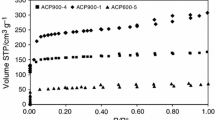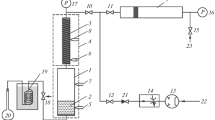Abstract
The adsorption process of 3-chloro phenol from aqueous solution on a activated carbon prepared from African palm stone and which presents a specific surface area of 685 m2 g−1, a greater quantity of total acid groups and a pHPZC of 6.8 is studied. The adsorption isotherms are determined at pH values of 3, 5, 7, 9 and 11. The adsorption isotherms are fitted to the Langmuir model and the values of the maximum quantity adsorbed that are between 96.2 and 46.4 mg g−1 are obtained along with the constant KL with values between 0.422 and 0.965 L mg−1. The maximum quantity adsorbed diminishes with the pH and the maximum value for this is a pH of 5. The immersion enthalpies of the activated carbon in a 3-chloro phenol solution of constant concentration, of 100 mg L−1, are determined for the different pH levels, with results between 37.6 and 21.2 J g−1. Immersion enthalpies of the activated carbon in function of 3-chloro phenol solution concentration are determined to pH 5, of maximum adsorption, with values between 28.3 and 38.4 J g−1, and by means of linearization, the maximum immersion enthalpy is calculated, with a value of 41.67 J g−1. With the results of the immersion enthalpy, maximum quantity adsorbed and the constant KL, establish relations that describe the adsorption process of 3-chloro phenol from aqueous solution on activated carbon.







Similar content being viewed by others
References
Lin SH, Juang RSJ. Adsorption of phenol and its derivatives from water using synthetic resins and low-cost natural adsorbents. A review Environ Manag. 2009;90:1336–49.
McGuire MJ, Suffet IH. Treatment of water by granular activated carbon. Washington D.C: American Chemical Society; 1983.
Mattson JS, Mark HB Jr. Activated carbon: surface chemistry and adsorption from solution. New York: Marcel Dekker; 1971.
Wang SL, Tzou YM, Lu YH, Sheng G. Removal of 3-chlorophenol from water using rice-straw-based carbon. J Hazard Mater. 2007;147:313–8.
Hamdaoui O, Naffrechoux E. Modeling of adsorption isotherms of phenol and chlorophenols onto granular activated carbon: part. I. two-parameter models and equations allowing determination of thermodynamic parameters. J Hazard Mater. 2007;147:381–94.
Merzougui Z, Addoun F. Effect of oxidant treatment of date pit activated carbons application of the treatment of waters. Desalination. 2008;222:394–403.
Hsieh C.-T, Hsisheng T. Liquid-phase adsorption of phenol onto activated carbon prepared with different activation levels. J Colloid Interface Sci 2000;230:171–5.
Mohamed FSh, Khater WA, Mostafa MR. Characterization of phenols sorptive properties of carbons activated by sulphuric acid. Chem Eng J. 2006;116:47–52.
Dabrowski A, Podkoscielny P, Hubicki Z, Barczak M. Adsorption of phenolic compounds by activated carbon - a critical review. Chemosphere. 2005;58:1049–70.
Ahmaruzzaman M, Sharma DK. Adsorption of phenols from wastewater. J Colloid Interface Sci. 2005;287:14–24.
Giraldo L, Moreno JC. Determinación de la entalpía de inmersión de carbón activado en soluciones acuosas de fenol y su relación con la capacidad de adsorción. Rev Colomb Quím. 2003;32:45–54.
Lopez-Ramon M, Stoeckli F, Moreno-Castilla C, Carrasco-Marin F. On the characterization of acidic and basic surface sites on carbons by various techniques. Carbon. 1999;37:1215–21.
Ladino-Ospina Y, Giraldo L, Moreno-Piraján JC. Calorimetric study of the immersion heats of Lead (II) and Chromium (VI) from aqueous solutions of Colombian coffee husk. J Therm Anal Cal. 2005;81:435–40.
Giraldo L, Moreno JC. Calorimetric determination of activated carbons in aqueous solutions. J Therm Anal Cal. 2007;89:589–94.
Rytwo G, Ruiz-Hitzky E. Enthalpies of adsorption of methylene blue and crystal violet to montmorillonite. J Therm Anal Cal. 2003;71:751–9.
Tseng RL, Wu FC, Juang RS. Liquid-phase adsorption of dyes and phenols using pinewood-based activated carbons. Carbon. 2003;41:487–95.
Moreno-Castilla C, Rivera-Utrilla J, López-Ramón MV, Carrasco-Marín F. Adsorption of some substituted phenols on activated carbons from a bituminous coal. Carbon. 1995;33:845–51.
Eley DD, Pines H, Weisz PB, editors. Advances in Catalysis. New York: Academic Press; 1966.
Diaz CM, Briceño N, Baquero MC, Giraldo L, Moreno JC. Influence of temperature in the processes of carbonization and activation with CO2 in the obtainment of activated carbon from African Palm pit. Study of the modification of characterization parameters. Int J Chem. 2003;6:1–15.
Giraldo L, Moreno JC, Huertas JI. A heat conduction microcalorimeter to determination of the immersion heats of activated carbons into aqueous solutions. Inst Sci Technol. 2002;30:177–86.
Zielenkiewicz W. Towards classification of calorimeters. J Therm Anal Cal. 2008;91:663–71.
Turmuzi M, Daud WR, Tasirin SM, Takriff MS, Iyeke SE. Production of activated carbon from candlenut shell by CO2 activation. Carbon. 2004;42:453–5.
Laszlo K, Tombacz E, Novak C. pH-dependent adsorption and desorption of phenol and aniline on basic activated carbon. Colloid Surf A:Physicochem Eng Aspects. 2007;306:95–101.
Finnin BA, O’Neill MAA, Gaisford M, Beezer S, Hadgraft A, Sears J. Performance validation of step-isothermal calorimeters. J Therm Anal Cal. 2006;83:331–4.
Wadsö I, Wadsö L. Systematic errors in isothermal micro and nanocalorimetry. J Therm Anal Cal. 2005;82:553–8.
Rodriguez GA, Giraldo L, Moreno JC. Calorimetric study of the immersion enthalpies of activated carbon cloths in different solvents and aqueous solutions. J Therm Anal Cal. 2009; doi:10.1007/s10973-007-8976-9.
Vieira EF, Cestari AR, Santos EB, Dias FS. Interaction of Ag(I), Hg(II) and Cu(II) with 1, 2-ethanedithiol immbilized on chitosan: thermochemical data from isothermal calorimetric. J Colloid Interface Sci. 2005;289:42–7.
Acknowledgements
The authors wish to thank the Master Agreement established between the Universidad de los Andes and the Universidad Nacional de Colombia and the Memorandum of Understanding entered into by the Departments of Chemistry of both Universities.
Author information
Authors and Affiliations
Corresponding author
Rights and permissions
About this article
Cite this article
Giraldo, L., Moreno, J.C. Immersion enthalpy and the constants of Langmuir model in the 3-chloro phenol adsorption on activated carbon. J Therm Anal Calorim 100, 695–700 (2010). https://doi.org/10.1007/s10973-009-0192-3
Received:
Revised:
Accepted:
Published:
Issue Date:
DOI: https://doi.org/10.1007/s10973-009-0192-3




